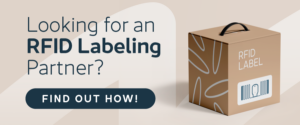
Frequently Asked Questions
RFID stands for Radio Frequency Identification.
This technology uses Radio Signals to communicate a unique identity wirelessly, thanks to a microchip located in the RFID tag that contains the tag’s unique ID number (called Electronic Product Code or EPC).
Two different tags will never have the same ID number.
The RFID solution for General Merchandise retailers is implemented to improve inventory accuracy and get traceability of goods at the item level from source to shop in almost real-time.
If you are a Walmart Vendor
In 2020, Walmart started implementing RFID technology in stores for Apparel.
Since then, they saw dramatic results with improved on-hand accuracy, leading to increased online order fulfillment, sell through and customer satisfaction.
They expanded RFID to additional departments with the goal of their stores being fully RFID enabled. The more RFID Walmart implemented the better results became.
CLICK HERE to see which departments are included in this expansion and how to get information about the deadlines.
If you are a Dick’s Sporting Goods Vendor:
Dicks Sporting Goods began leveraging RFID technology in store in 2023 and expanded their initiatives to RFID tag their private brands in apparel.
They expanded RFID to Team Sports (hardlines) with the goal to have as much of their store tagged for inventory management.
CLICK HERE to see which departments are included in this expansion and how to get information about the deadlines.
Checkpoint has a full range of RFID inlays that meet the ARC specifications for use on General Merchandise.
Depending on the retailer you are working with, or if you are just starting your RFID journey, we have pre-selected inlays that will meet the requirements for general merchandise:
This identity is known as the Electronic Product Code (EPC) and is composed of a GTIN (UPC or EAN barcode), and a serial number. Since this serial number range is available per UPC/EAN, there is a significant quantity of EPC combinations that can be used to maintain uniqueness.
Typically, the easiest method to maintain serialization across multiple suppliers would be to manage serial number ranges.
It is the assumed responsibility of the UPC/EAN owner to ensure multiple vendors are not encoding RFID tags for the same item.
In order to combat any tampering, chip providers have created the capability to lock (requiring a password to write to the tag), or permalock (blocking the chip from ever being rewritten) their user memory.
The end user of the RFID label (the retail store) determines the locking requirements of the label.
Based on industry standards, Checkpoint’s best practice is to lock or permalock tags unless otherwised specified by the end user of the label (retailer). While unlocked tags have certain use cases, they are less popular due to the growing knowledge on how to tamper with RFID encoding. Without the EPC matching the database of the environment it is in, the tag will not function accordingly.
RFID Tags encoded by Checkpoint Systems will be permalocked for the Walmart and Dick’s Sporting Goods RFID programs.
GS1 provides a tool that allows you to validate your company’s GS1 registration either by company name, or GTIN (which is a UPC or EAN).
To search the Registration records, please go to the site https://gepir.gs1.org/ and select the appropriate option. If you do not have a registered GS1 GTIN, then you will need to register your UPC with GS1 prior to sample creation.
You can find the Auburn Sample Submission Guide here.

